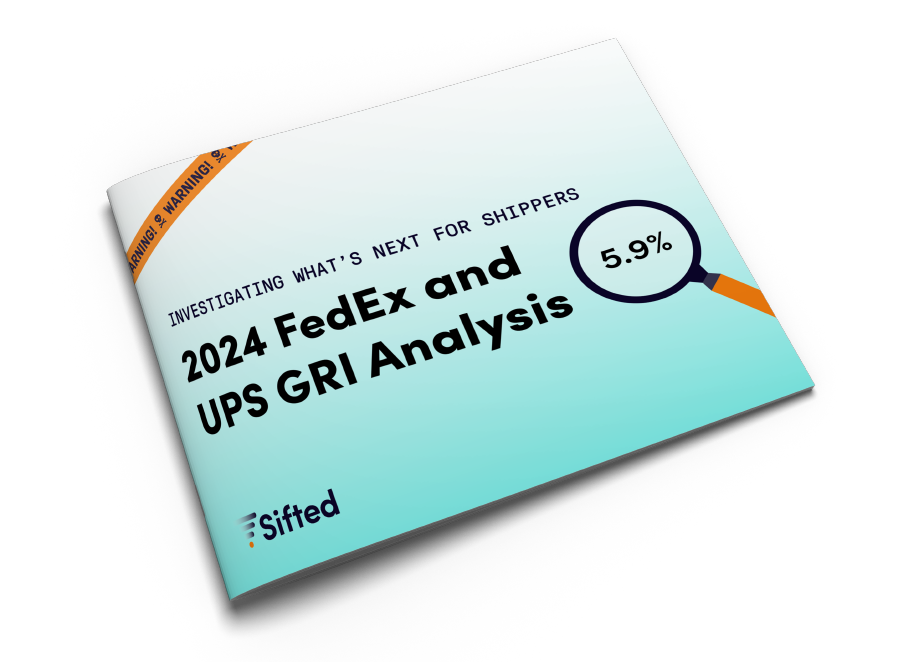Understanding FedEx Shipping Rates
Shipping costs are a major concern for many retailers as they try to deliver their orders to customers quickly and cost-effectively. If you are a B2C seller worried about soaring FedEx shipping rates, you first need to determine how much a package costs to ship and whether it’s possible to reduce those costs.
But before you sit down to optimize shipping costs, it’s important to understand the ins and outs of FedEx shipping estimates to avoid pitfalls.
In this article, we’ll look at the different factors involved in FedEx price estimations and go over resources that help you more accurately forecast your shipping expenses.

2024 FedEx & UPS GRI Analysis
FedEx Shipping Zones
Shipping zones are regions or territories where you ship your packages. The zones are determined based on the distance the package travels from the shipper to the customer.
FedEx shipping zones are numbered between 1 and 8 for all domestic shipments. The point of origin is always Zone 1, whereas the destination shipping zone depends on the final destination. The farther the destination from the origin, the higher the shipping zone’s number will be.
Shipping to higher zones results in higher shipping costs.
You can find the shipping zones for your shipment by entering the destination and origin ZIP codes in the FedEx zone locator tool.
FedEx Freight Zone Locator
FedEx zone locator allows you to find the shipping rate for your shipment based on the package weight and the FedEx service you choose.
- Navigate to http://fxfzonelocator.van.fedex.com/. Here you can create a customized zone chart for locations in the U.S. or Canada based on inbound or outbound shipments. Enter your details and click Get your zone locator.
- A PDF download will automatically be prompted with destination zip codes and shipping zones (including Contiguous U.S. states, Alaska, and Hawaii) based on your originating ZIP code.
- Find your destination ZIP code in the zone chart here.
- Next, look for the corresponding shipping zone, and navigate to the FedEx rate tables resource.
- Here, find the shipping rate according to the shipment weight and where your FedEx Home Delivery, FedEx Express, or FedEx Ground delivery is going.
FedEx Ground Transit Information and Service Maps
You can use FedEx Ground service maps to find the transit times from the ZIP/Postal code. Here’s how you can check at what time your packages will be scheduled for delivery:
- Go to https://www.fedex.com/grd/maps/ShowMapEntry.do.
- Enter the origin ZIP/Postal code in the required field.
- Next, choose the country and whether your shipment is residential using the dropdown lists.
- Select an option based on if the delivery is outbound or inbound and click “view map.”
- A color-coded chart and map will appear on the screen.
For example, a package sent to a destination colored in pink will be scheduled for delivery the next business day, i.e., one day after the carrier picks it up.
The transit map and chart generally represent FedEx Ground rates and transit times. You can find accurate transit quotes using the FedEx delivery and shipping rates tool.
FedEx Global Third-party Zones and Rates
FedEx’s global third-party billing option charges the bill to someone other than the sender or the recipient. However, charges for shipments within the U.S. are billed only to a third party in the U.S. In addition, FedEx also charges a third-party billing surcharge for every shipment.
Here’s how you can determine the third-party zones and shipping charges for your shipments:
- Start by downloading the FedEx global third-party region resource. You can click Guam or Hong Kong based on where you are paying from.
- Once you’ve opened the FedEx global third-party region resource, find your origin and destination countries and their corresponding regions. Let’s suppose Brazil with region OF as origin zone and Canada with region OB as destination zone.
- Next, go to the last page of the resource and find the zone that corresponds with regions OF origin zone and destination OB. In this case, the resulting zone is B.
- From here, you can use the rate tables for Guam or Hong Kong to calculate shipping fees based on your zone, weight combination, and service.
Understanding UPS and FedEx Shipping Zones
Affordable and fast shipping is essential for eCommerce retailers and customers. For this reason, shippers should keep a close eye on their shipping rates. Shipping zones, combined with package weight and dimensions, determine the time and cost of shipping.
Given the same service level, two packages sent from the same location to different shipping zones will have different shipping fees and delivery times. For example, if one parcel is sent to Zone 3 and the other to Zone 7 from the same place, Zone 3 will have a lower shipping cost and be delivered sooner than the parcel going to Zone 7.
Here’s a look at FedEx’s standing shipping zones:
Zone 1: 0-50 miles
Zone 2: 51-150 miles
Zone 3: 151-300 miles
Zone 4: 301-600 miles
Zone 5: 601-1,000 miles
Zone 6: 1,001-1,400 miles
Zone 7: 1,401-1,800 miles
Zone 8: 1,801+ miles within the contiguous U.S.
You can either use the FedEx service guide to calculate shipping rates by zone, weight, and service or use the FedEx rates tool to calculate the shipping fees.
You can find the shipping zone for your shipments by downloading the shipping zone chart based on your ZIP code. Determine the shipping by comparing the first three digits of the recipient’s ZIP code with the chart. For instance, a parcel shipped from Boston, MA 02108 to New York, NY 11105 that falls into the destination zip code that starts with 004 is:
Zone 003 if the package is sent using UPS Ground service
Zone 303 if the package is sent using UPS 3 Day Select
Zone 203 if the package is sent using UPS UPS 2nd Day Air
Zone 243 if the package is sent using UPS 2nd Day Air A.M.
Zone 133 if the package is sent using UPS Next Day Air Saver
Zone 103 if the package is sent using UPS Next Day Air
Finally, you can calculate the shipping rates for your shipment using the UPS Daily Rate and Service Guide.
See how shipping zones affect your bottom line with Sifted
eCommerce retailers find it difficult to control their shipping costs with the volatile nature of carrier fees. Still, they can protect their profit margins by figuring out factors affecting their shipping expenses and taking steps to optimize their shipping operations to meet their financial goals.
Sifted Logistics Intelligence gives you complete visibility into your logistics operations in one place. It offers tools to help you better understand and optimize costs using AI-powered demand forecasting.
Ready to protect your business from unexpected shipping costs? Get a demo with Sifted today!











